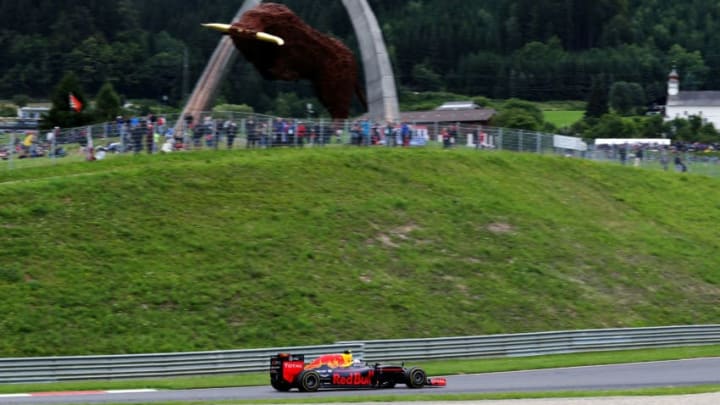Formula 1 returned to Austria in 2014 after an 11-year break. What can the last five races at the Red Bull Ring tell us about this year’s event?
Undoubtedly throughout the Austrian Grand Prix weekend, you’ll hear mention of how the Red Bull Ring is built in the shadow of the original Österreichring and also how the rebuilt track is more to the current favor of Formula 1.
The current track that drivers use is a 2.683-mile (4.318-kilometer) circuit that looks more at home on a Formula E calendar than a Formula 1 calendar, and we can all thank Red Bull energy drinks for that, as it was bought by Red Bull in 2011 after the original track was demolished in 1995 and then rebuilt.
Let’s look back at the last five Austrian Grands Prix before this weekend’s running of the race.
2003
Michael Schumacher won the race from the pole position. That wasn’t a shock, as Scuderia Ferrari were still in the midst of a dominant run that started back in 2000. But what was memorable about the 2003 race at the then dubbed A1-Ring is the fact that several cars encountered terminal mechanical problems, which caused drivers in the midpack to be able to get into the top 10, including Jaguar Racing’s Mark Webber, who finished P7 after starting P17.
2014
Formula 1 did not return to Austria until 2014, which was 11 years and one €70 billion Red Bull-funded renovation later. Despite the 11 years in between races, the 2003 and 2014 races were very similar. Red Bull Racing driver Sebastian Vettel and both Toro Rosso drivers retired due to mechanical failures.
Despite Williams’ Felipe Massa claiming a miracle pole position, the race was Mercedes’ from lights out. The winning gap was relatively close at just over two seconds from race winner Nico Rosberg to second place finisher Lewis Hamilton, and a driver from the midfield made a charge into the points, as Force India’s Sergio Perez finished P6 after starting P15.
2015
The 2015 race was less of a race and more of a Mercedes casual Sunday drive — for Rosberg, at least. He led 68 of the race’s 71 laps and cruised to victory by nearly nine seconds over his teammate and race polesitter Hamilton.
The 2015 race showed how dominant the Mercedes cars were at the short and high-speed Red Bull Ring. Despite the fact that Red Bull were the hosts of the race, their teams’ race performances were poor. Toro Rosso’s Max Verstappen was the highest finisher of their four drivers in P8 after he started P7.
2016
More from Formula One
- Formula 1: Top Red Bull threat identified for 2024
- Formula 1: Why the Max Verstappen retirement obsession?
- Formula 1: Williams ‘mistake’ hints Logan Sargeant’s future
- Formula 1 awaiting key confirmation for 2024 season
- Formula 1: The ‘championship’ Max Verstappen only leads by 3 points
The 2016 race was one that Rosberg let get away. It was one race that was worth the wait until the end. Hamilton started on pole while his teammate started P6. The gap between the two Mercedes drivers meant that Hamilton’s fight in turn one was against drivers from rival teams. Force India’s Nico Hulkenberg started P2, McLaren’s Jenson Button started P3, Ferrari’s Kimi Raikkonen started P4 and Red Bull Racing’s Daniel Ricciardo started P5. For most of the race, Hamilton, Rosberg and Vettel, who started the race P9, swapped the lead among themselves.
Rosberg recaptured the lead with 10 laps to go, but unfortunately for him, Hamilton was using better tires and caught him with three laps to go. After several successful attempts at defending, Rosberg decided to put the squeeze on Hamilton and force his teammate wide with contact. However, Rosberg bore the brunt of the attempted proactive maneuver and Hamilton went on to win the race while Rosberg had to settle for P4 in a damaged W07.
2017
Continuing the tradition of terminal mechanical failures at the Red Bull Ring, the races of Toro Rosso’s Carlos Sainz Jr. and Haas’ Kevin Magnussen ended prematurely. The races of Verstappen and Fernando Alonso did as well as a result of contact between the two on lap one. Despite the early retirements and the close margin of victory, which was just under two-thirds of a second, the race was a foregone conclusion for Valtteri Bottas, as he led 69 of the race’s 71 laps and was able to stay in front of Vettel, who started and finished the race in P2.
Next: Top 10 Formula 1 drivers of all-time
Expect to see the usual mechanical retirements, lapped cars and midfield chargers during the 2018 Austrian Grand Prix, which is scheduled to be broadcast live from the Red Bull Ring on Sunday, July 1 starting at 9:10 a.m. ET.
